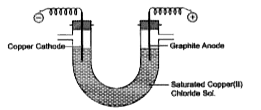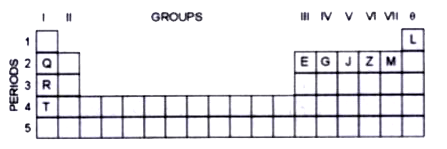Study the extract of the Periodic Table given below and answer the questions. Give the alphabet corresponding to the element in question. Do not repeat an element. State which element: Is an inert gas. State the ion of which element will migrate:Towards the cathode during electrolysis
To solve the question, we will break it down into two parts based on the requirements.
Step 1: Identify the Inert Gas
1. Understanding Inert Gases: Inert gases, also known as noble gases, are found in Group 18 of the periodic table. They are characterized by having a full valence shell, making them very stable and unreactive.
2. Locate Group 18: From the periodic table extract, we need to identify which element corresponds to Group 18.
3. Identify the Element: In the extract, the element labeled as "F" is the one that belongs to Group 18. Therefore, the answer for the inert gas is:
- Element F.
Step 2: Determine the Ion Migrating Towards the Cathode
1. Understanding Electrolysis: During electrolysis, cations (positive ions) migrate towards the cathode (negative electrode) to gain electrons.
2. Identify the Elements: From the periodic table extract, we need to identify the elements that can form cations. Typically, metals can lose electrons to form positive ions.
3. Identify the Elements A and B: Based on the video transcript, element A is hydrogen and element B is magnesium.
4. Compare Reduction Potentials: The reduction potential of hydrogen (0 V) is greater than that of magnesium (approximately -2.36 V). This means hydrogen is more likely to gain electrons and migrate towards the cathode.
5. Conclusion: Therefore, the ion of element A (hydrogen) will migrate towards the cathode during electrolysis. Thus, the answer for the ion migrating towards the cathode is:
- Element A.
Final Answers:
- Inert Gas: F
- Ion Migrating Towards Cathode: A
---
1. Understanding Inert Gases: Inert gases, also known as noble gases, are found in Group 18 of the periodic table. They are characterized by having a full valence shell, making them very stable and unreactive.
2. Locate Group 18: From the periodic table extract, we need to identify which element corresponds to Group 18.
3. Identify the Element: In the extract, the element labeled as "F" is the one that belongs to Group 18. Therefore, the answer for the inert gas is:
- Element F.
1. Understanding Electrolysis: During electrolysis, cations (positive ions) migrate towards the cathode (negative electrode) to gain electrons.
2. Identify the Elements: From the periodic table extract, we need to identify the elements that can form cations. Typically, metals can lose electrons to form positive ions.
3. Identify the Elements A and B: Based on the video transcript, element A is hydrogen and element B is magnesium.
4. Compare Reduction Potentials: The reduction potential of hydrogen (0 V) is greater than that of magnesium (approximately -2.36 V). This means hydrogen is more likely to gain electrons and migrate towards the cathode.
5. Conclusion: Therefore, the ion of element A (hydrogen) will migrate towards the cathode during electrolysis. Thus, the answer for the ion migrating towards the cathode is:
- Element A.
- Inert Gas: F
- Ion Migrating Towards Cathode: A
Topper's Solved these Questions
- BOOK - ICSECHAPTER - PERIODIC TABLE (PERIODIC PROPERTIES AND VARIATION OF PROPERTIES)EXERCISE - ADDITIONAL QUESTIONS74videos
PERIODIC TABLE (PERIODIC PROPERTIES AND VARIATION OF PROPERTIES)
- BOOK - ICSECHAPTER - PERIODIC TABLE (PERIODIC PROPERTIES AND VARIATION OF PROPERTIES)EXERCISE - ADDITIONAL QUESTIONS (Fill in the blanks with the appropriate word/s in each case.)24videos
PERIODIC TABLE (PERIODIC PROPERTIES AND VARIATION OF PROPERTIES)
- BOOK - ICSECHAPTER - PERIODIC PROPERTIES AND VARIATIONS OF PROPERTIESEXERCISE - ASSERTION AND REASON BASED QUESTIONS5videos
PERIODIC PROPERTIES AND VARIATIONS OF PROPERTIES
- BOOK - ICSECHAPTER - PRACTICAL CHEMISTRY EXERCISE - Questions from Previous ICSE Board Papers (2017)2videos
PRACTICAL CHEMISTRY
Similar Questions
Study the extract of the Periodic Table given below and answer the questions. Give the alphabet corresponding to the element in question. Do not repeat an element. State which element: Is non-metallic and has a valency of 2.
View SolutionStudy the extract of the Periodic Table given below and answer the questions. Give the alphabet corresponding to the element in question. Do not repeat an element. State which element: Forms an electrovalent compound with G.
View Solution
Knowledge Check
- Question 1 - Select One
Study the given figure and answer the question that follow:

Name the ions which will migrate to cathode.AHydrogen ions (H+)BCopper ions (Cu2+)CChloride ions (CI−)DBoth (a) and (b) - Question 2 - Select One
The diagram given below is a part of Periodic Table. Study the table and answer the questions given below the table :

Name two elements in same group of Periodic TableAOxygen and UraniumBOxygen and sulphurCCalcium and HydrogenDCromium and Rubidium
Study the extract of the Periodic Table given below and answer the questions that follow. Give the alphabet corresponding to the elements in question. DO NOT repeat an element.

Which is an inert gas ?View SolutionUse the letters only written in the Periodic Table given below to answer the questions that follow :

Which metallic element is more reactive than R?View SolutionUse the letters only written in the Periodic Table given below to answer the questions that follow :

Which element shown forms ions with a single negative charge ?View SolutionAn element has an atomic number 16. State the period to which it belongs.
View SolutionUse the letters only written in the Periodic Table given below to answer the questions that follow :

Which element has its electrons arranged in four shells ?View SolutionUse the letters only written in the Periodic Table below to answer the question : Which element has its electrons arranged in four shells.
 View Solution
View Solution

